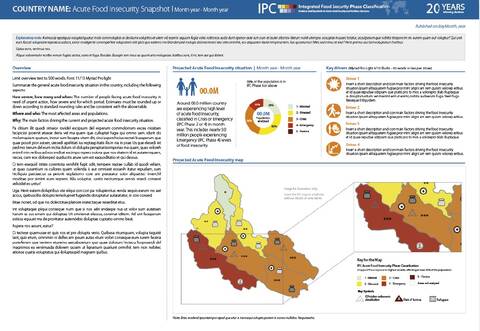Extended Snapshots

Type and Objective of Product
Simplified Analysis Product
The Extended Snapshot is an in-depth, standalone, and visually engaging infographic highlighting key findings from an IPC acute food insecurity and malnutrition analysis. Designed to replace the IPC report, it simplifies complex data into an accessible format, making it suitable for detailed reference by both technical and non-technical audiences.
Ownership
The Extended Snapshot is produced by the IPC GSU, based on the outcomes of the IPC TWG AFI and AMN reports in cases when the report is either delayed or cancelled. The GSU facilitates the development and finalisation of the Extended Snapshot, ensuring consistency and credibility, while ownership of the findings and content is joint with the GSU and the TWG.
Mandatory Content
Each Extended Snapshot includes the following key components:
- Overview: High-level joint overview of key findings of the current and projections (500 words).
- Key Drivers (AFI): Analysis of the factors contributing to the crisis (60 words for each blurb).
- Contributing Factors (AMN): Analysis of the factors contributing to the crisis (60 words for each blurb).
- IPC Maps AFI & AMN: The current and projected acute food insecurity and malnutrition situation, complemented by visual representations such as graphs.
- Recommended Actions: Actionable steps for response and mitigation.
- Thematic Data: Provides an in-depth analysis of primary drivers, such as conflict, drought, and other key factors influencing food insecurity and malnutrition.
- Other Data: Key complementary data such MAM Vs SAM trend graphs.
- Population Tables: Summaries of population estimates.
Target Audience
The Extended Snapshot is designed to meet the needs of a diverse range of technical audiences, including:
- Donors (Primary): International donors providing critical funding and resources for humanitarian efforts.
- Media and Advocacy Groups (Primary): Organisations disseminating findings to raise public awareness.
- Humanitarian Agencies: UN agencies, NGOs, and donors are involved in planning and implementing interventions.
- Government Authorities: National and regional authorities.
- Academics and Researchers: Experts and analysts studying food security trends and crisis dynamics.
- Policy Makers: Officials tasked with resource allocation, strategic planning, and policy.
Branding and Format
The Extended Snapshot follows standardised branding to ensure consistency and credibility:
- Size: Standard A3 format, designed for optimal printing and suitable for A2 wall pinning.
- IPC Logo and Color Scheme: The report features the signature IPC blue (CMYK 94 63 13 1, RGB 1 97 156, Web Hex #01619c) with the logo strip at the top.
- Partner Logos: The logos of all TWG partners involved in the analysis are displayed alphabetically on the last page.
- Fonts: The primary and secondary font is Myriad Pro, a sans-serif typeface with a classic and fresh appearance that aligns with the IPC brand.
- Pagination: The Extended Snapshot should be a minimum of one or two pages.
Log Information and Disclaimers
- Mandatory Log Information: Publication date and TWG contact details.
- Disclaimers
- Standard Map Disclaimer: Apply the official IPC map disclaimer. See IPC Mapping Guidelines
- Non-Endorsement Disclaimer: If the government does not endorse the analysis, include a disclaimer stating that the government has not yet endorsed the findings by the time of publication.
Dissemination
Extended Snapshots are distributed through multiple channels to maximise reach and impact, including:
- The IPC website.
- Email blasts targeting key stakeholders, especially for the Top Ten Crises.
- Social media platforms such as X (formerly Twitter) and LinkedIn.
This multi-channel dissemination strategy ensures that Extended Snapshots are accessible to diverse audiences, including policymakers, humanitarian organisations, and the public.